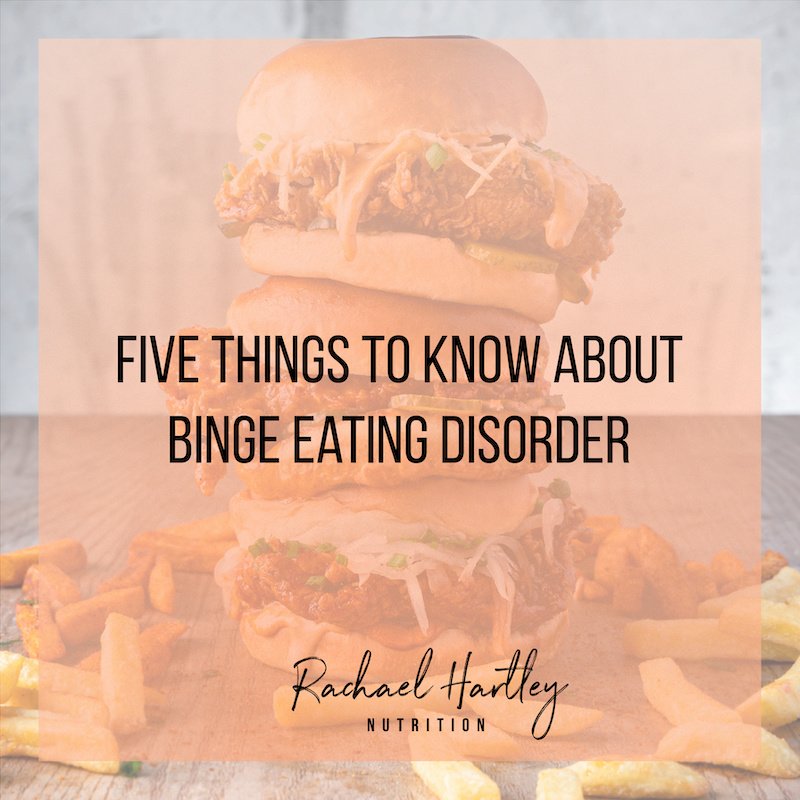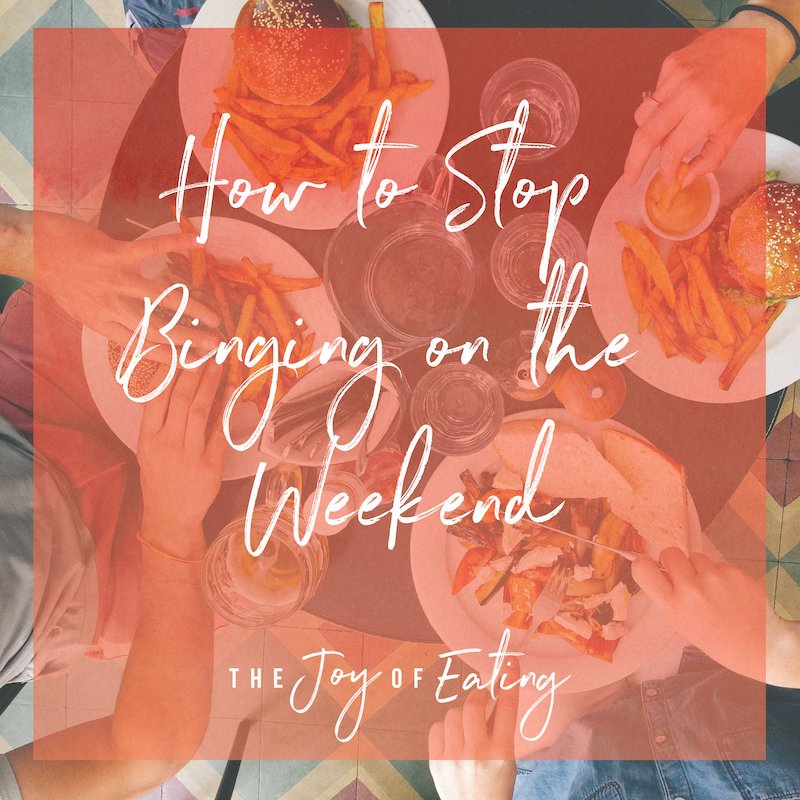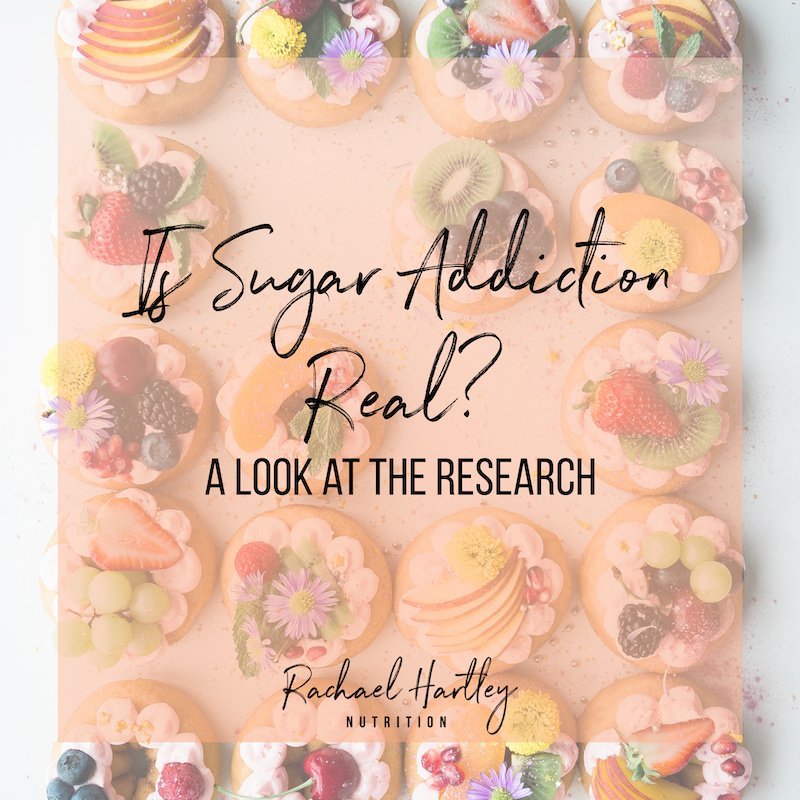Five Things to Know About Binge Eating Disorder
Binge eating disorder is perhaps the most stigmatized and misunderstood of eating disorders, thanks to it’s association with higher weights and out of control eating. Read this post on five things to know about binge eating disorder so you can better understand this serious disorder, and it’s treatment.
Binge eating disorder (BED) is arguably the most misunderstood and stigmatized of eating disorders. Because the eating disorder is associated with a loss of control, overeating, and higher weight bodies, it’s often thought of as being less serious. Even worse, it’s often chalked up to low willpower, when in fact BED is a serious mental illness that can have a devastating impact on the lives of people suffering with it.
According to the DSM-5 (the manual for diagnosing psychiatric disorders), binge eating disorder is diagnosed by:
Recurrent episodes of binge eating, which is characterized by eating a large quantity of food in a discrete period of time, accompanied by a sense of lack of control.
The binge eating is associated with three (or more) of the following: eating until uncomfortably full, eating faster than typical, eating when not feeling physically hungry, eating alone out of embarrassment, and/or feeling deeply disgusted, depressed or embarrassed afterwards
Marked distress/intense shame over binge eating.
The binge eating occurs, on average, at least once a week for three months.
The binge eating is not associated with the recurrent use of inappropriate compensatory behavior (for example, purging) and does not occur exclusively during the course of anorexia nervosa, bulimia nervosa, or avoidant/restrictive food intake disorder.
Of course, binge eating can occur outside a formal diagnosis of binge eating disorder, and can occur as part of other eating disorders. Most people with an eating disorder don’t fall into a nice little diagnostic box.
Also, much of the diagnostic criteria is subjective. Who decides what a large quantity of food is? What if someone doesn’t eat all day - wouldn’t it be normal to eat a larger amount of food than usual? Since diet culture has distorted our perception of what a “normal” amount of food is, often people will describe a binge, when in reality they’ve eaten a quite typical amount of food.
Adding to the complexity of diagnosis is the fact that some aspects of binge eating are incredibly common, and aren’t necessarily indicative of disordered eating. For example, eating until physically uncomfortable happens sometimes, and it’s not something we want to jump to pathologize.
Regardless of whether you have a formal diagnosis of binge eating disorder or not, if your relationship with food is impacting your quality of life, you deserve support. If you seek out treatment, here are five things to know about binge eating disorder:
Five Things to Know About Binge Eating Disorder
Restriction is part of binge eating disorder.
While BED is characterized by bingeing, there’s an argument to make that it is a restrictive eating disorder. Bingeing doesn’t happen in a vacuum. There is a restrict-binge cycle, where restriction fuels binge eating behaviors. While some people may binge as a trauma response, or in reaction to intense, uncomfortable emotions, without restriction (either physical OR emotional), it’s unlikely bingeing would occur.
Sidebar: If physical and emotional restriction are new terms for you, to briefly recap, physical restriction is when one doesn’t allow themselves to eat certain foods/food groups or undereats, and emotional restriction is when one still allows themselves to eat certain foods, but feels intense shame or guilt for it.
In binge eating disorder, physical restriction doesn’t rise to the degree that would lead to a diagnosis of anorexia, but that doesn’t mean the effect of undereating isn’t powerful. When our body is underfed, it sends out loud signals in the form of intense hunger cues. Every client I have worked with diagnosed with binge eating disorder has a long dieting history, and most have suffered from anorexia (formally diagnosed or not) in the past. The brain has experienced the trauma of starvation and malnutrition, so it’s much more reactive and protective when restriction arises. Something as simple as skipping a snack or undereating a meal can make one vulnerable to bingeing. In a way, it’s a really beautiful thing how your body will protect you from starvation - although I know it doesn’t feel that way after a binge!
Emotional restriction can be powerful too. It creates a fear that a food won’t be available in the future. How can you eat in a calm and intentional way when you’re afraid a food will be restricted at a later date? And what happens when you inevitably eat the food? Emotional restriction creates shame that fuels binge eating.
Binge eating disorder can occur at any size.
While binge eating disorder is associated with higher weights, people across the BMI spectrum can have binge eating disorder (reminder that BMI is totally unscientific, but it’s what researchers typically use). While many people do gain weight as a result of binging behaviors, not everyone will, or won’t gain enough to be categorized as “overweight” or “ob*se.”
Remember that eating disorder behaviors are dangerous, regardless of the impact on one’s weight. Not to mention that binge eating disorder is a mental health disorder - even if weight and health were synonymous (they’re not), people deserve treatment when something is negatively affecting their quality of life.
Binge eating serves a function.
Binge eating isn’t about gluttony or lack of willpower. Nor is it about taste or the pleasure of eating, since bingeing is a quite disconnected experience. In binge eating disorder, the binges serve a function. This varies from person to person, and common functions include numbing from intense feelings and emotions, self-harm/punishment, and release of anxiety/stress. Binge eating can also be part of a trauma response, an attempt to regulate the nervous system and bring one back into their window of tolerance.
While binge eating is a maladaptive behavior, it’s also important to recognize that it serves a function, and for some may be the only tool they have. In recovery, one learns how to tolerate distress, tools for reducing vulnerabilities for bingeing, and also learns other coping strategies they can use in place of binge eating.
Treatment involves learning to eat binge foods, not learning how to eliminate them.
Treatment for binge eating disorder is not learning how to successfully diet - although unfortunately many providers still treat it this way. Treatment for binge eating disorder involves learning how to competently eat the foods you binge on, and working on giving yourself full permission with those foods. If you’re feeling any sense of insecurity that a food won’t be available in the future, it’s hard to eat it without feeling stressed in the present.
Learning how to eat binge foods can look a lot of different ways. For some clients, we work on stocking binge foods - keeping a large amount of a food in the house to help create a sense of security that the food will always be there. For example, one of my clients who binged on Oreos stocked up on six boxes. While she definitely ate a lot of Oreos at first, by the time she got to the last box or two, she ended up having to throw them away for going stale. Now she still keeps Oreos in the house (because they are delicious), but rarely finishes a box before throwing it out, because she just eats them when she wants them.
For other clients we work on incorporating binge foods in a planned way. Another client who used to binge on candy after work started packing a few pieces with her lunch each day. This helped her incorporate candy in a way that felt safe, since she only had access to those few pieces, but also practice eating it in a connected, healthy way.
Regardless of which approach we take, the goal is building trust in oneself around binge foods, and building trust that those foods will be available in the future.
Treatment is available, and it’s not dieting.
Unfortunately, because binge eating disorder is viewed as a lack of willpower, many people who suffer from it seek out treatment in the form of weight loss programs and bariatric surgery. Binge eating is quite common among those seeking weight loss treatment, with about 9-29% reporting binge eating behaviors. Among people seeking bariatric surgery, rates of clinical binge eating disorder are higher, with up to 47% meeting criteria for diagnosis.
Healing from binge eating disorder does not come in the form of a diet - no matter your size. Dieting by nature forces one to eat less than their body needs, and to ignore their body’s cues. This creates an environment ripe for binge eating, in which one is hungry and disconnected.
Treatment looks different for everyone, but from a food perspective it involves learning how to feed your body adequately throughout the day, generally with a flexible meal plan that has 3 meals and at least a couple of snacks. A dietitian will work with you on reducing physical and emotional restriction, by supporting you in reintroducing binge foods, and unlearning myths about food, nutrition and weight that fuel shame around eating. If you are interested in working with a dietitian, we work with clients virtually and out of our Columbia,SC office. Learn more about our practice philosophy, and reach out if you’re interested in working together.
Binge eating disorder treatment also involves working with a multidisciplinary team, which generally consists of a therapist, primary care doctor, and may also involve a psychiatrist. When we work with clients healing from BED, we love to work alongside your team (or help you build one!) so you’re able to get comprehensive care, collaborative care.
People who suffer from binge eating disorder often struggle with overwhelming amounts of shame. I wish I had a magic wand to wipe that shame away, because binge eating is a pretty natural and understandable reaction to living in a culture that’s pretty messed up around food. As dietitians who have worked with countless individuals recovering from binge eating disorder, we know that reducing shame around binge eating is one of the most powerful ways of healing. As Brené Brown says:
“Shame cannot survive being spoken. It cannot tolerate having words wrapped around it. What it craves is secrecy, silence, and judgment. If you stay quiet, you stay in a lot of self-judgment.” ~ Brené Brown
You deserve a place where you can be open and honest about your struggles with food, and receive empathy and care in response.




